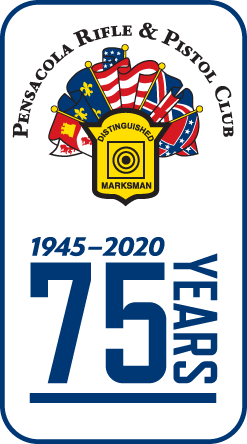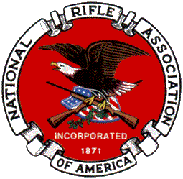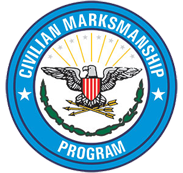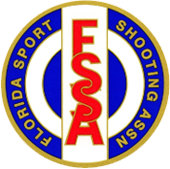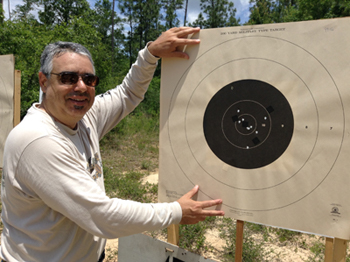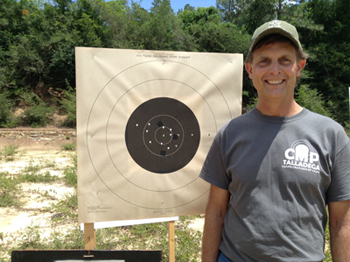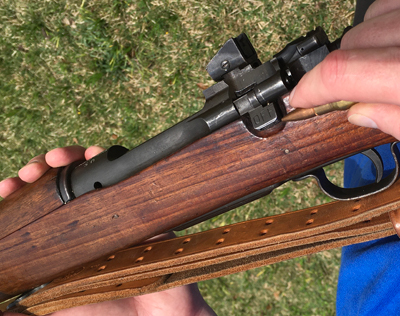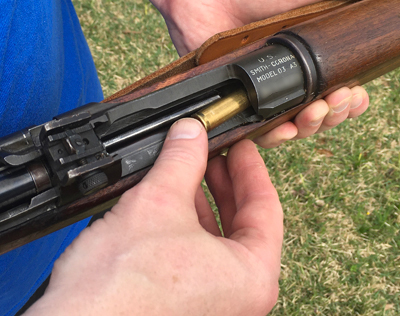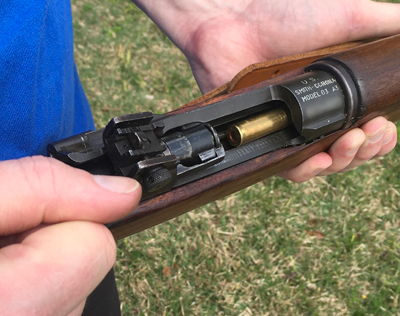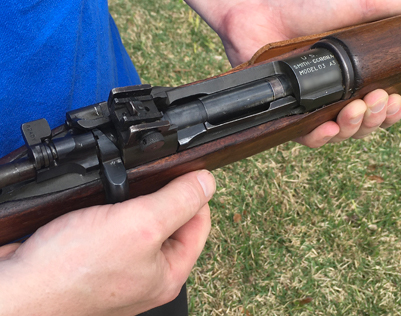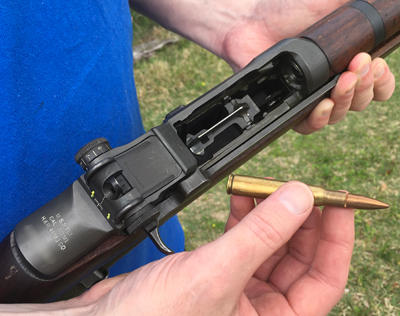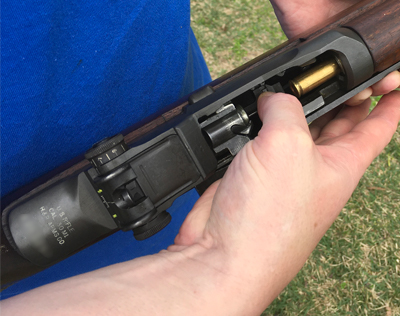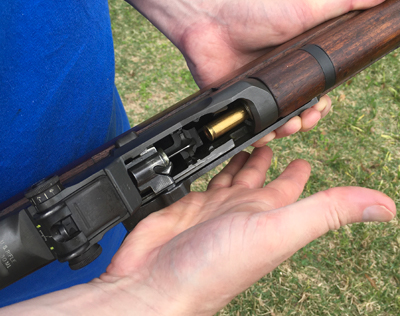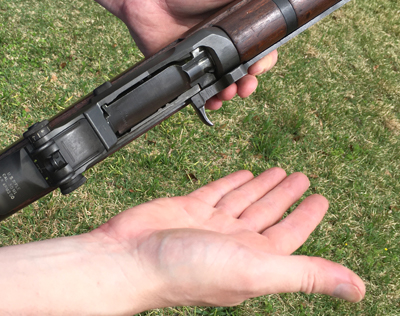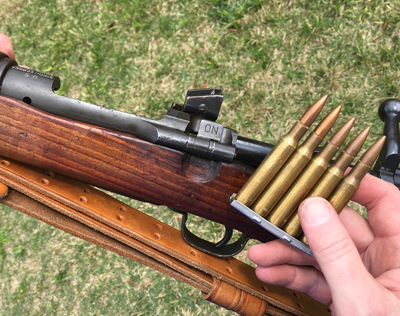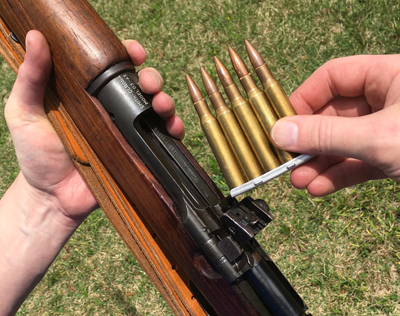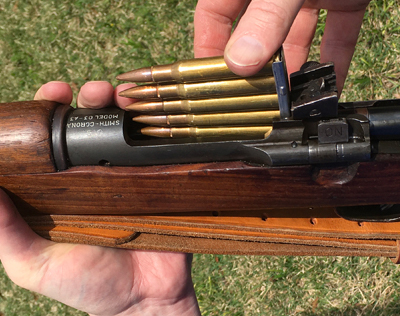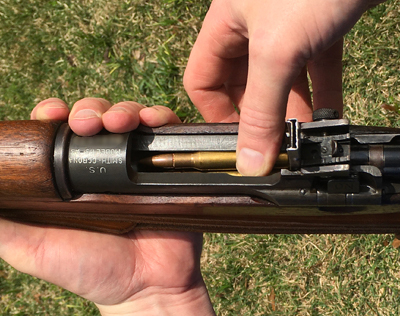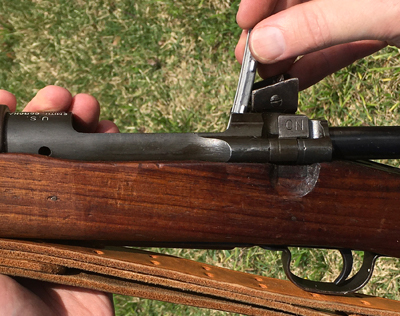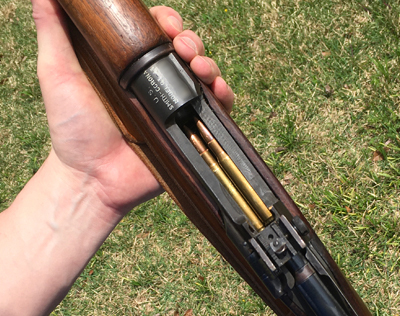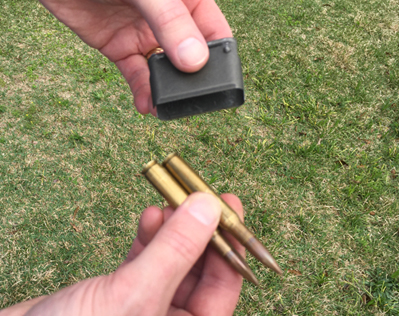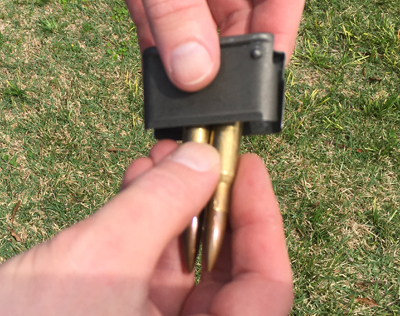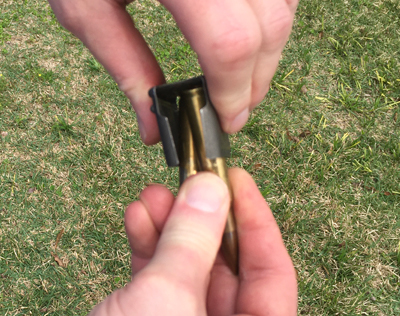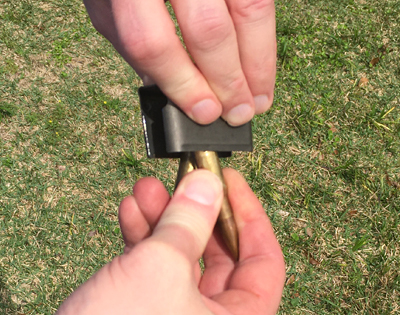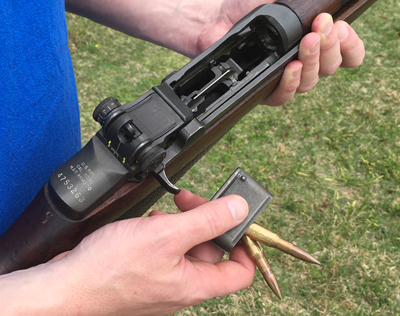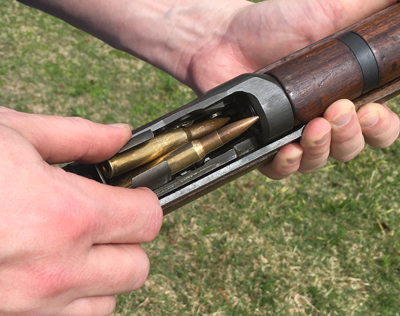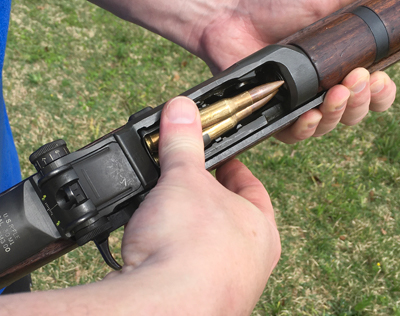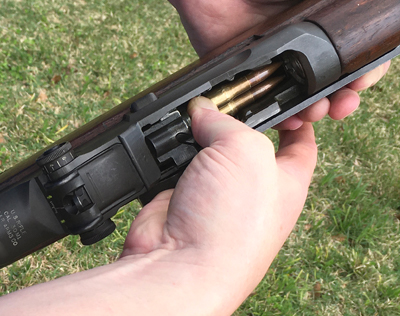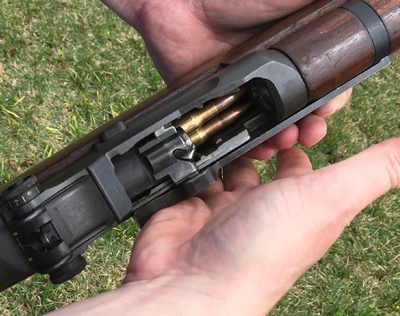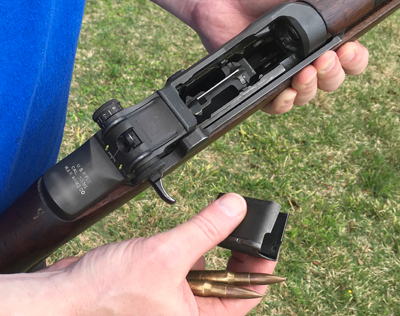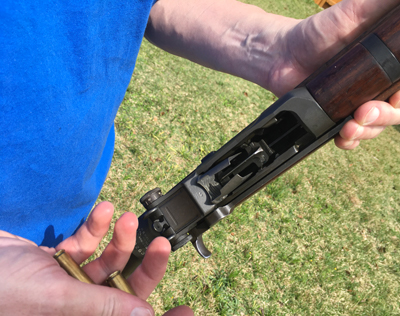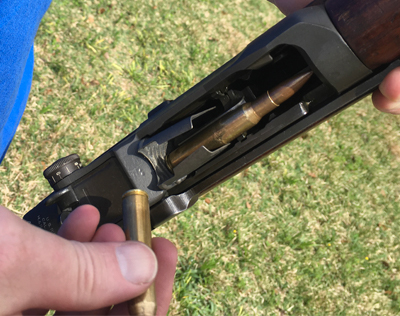Civilian Marksmanship Program's
Rifle Games - Information
Match date: May 1, 2021
Six rifle options are featured this year, they are fired concurrently and re-entry is allowed.
A rifle may be fired again in an additional relay as a "re-entry."
M1 Garand Match
M1 Garand Unlimited Match
Springfield Match
Vintage Military Bolt Rifle
Modern Military
Unlimited Modern Military
Time: First relay begins at 9:00 a.m. Additional relays will begin approximately 1.5 hours after the previous relay start.
CMP requires eye protection in matches sanctioned by them. See more information below.
CMP requires affidavit signed by competitor and Notary Public. For your convenience, this form is found on the last two pages of the match program. If you already have this form on file with Pensacola Rifle & Pistol Club, you do not have to submit it again. This is separate from the club's waiver.
Match fee: $10. per rifle fired. Currently planning up to four relays.
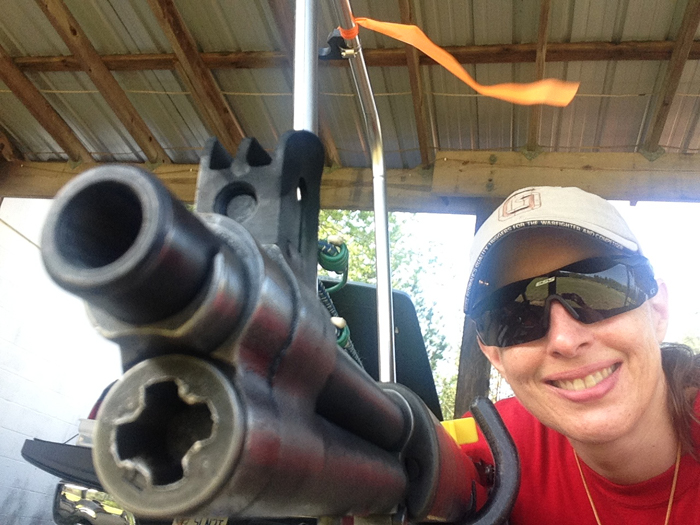
The match at our club's 200 yard rifle range.
Pensacola Rifle & Pistol Club will be holding some fun rifle matches to break out the older and current rifles, the Civilian Marksmanship Program's Rifle Games. Every match is shooter vs. target with all stages on the NRA SR-5 200 yard target. There are awards for all who fire within the CMP's bronze, silver and gold score ranges.
There are no target pits at our club, competitors walk downrange to score and reface targets.
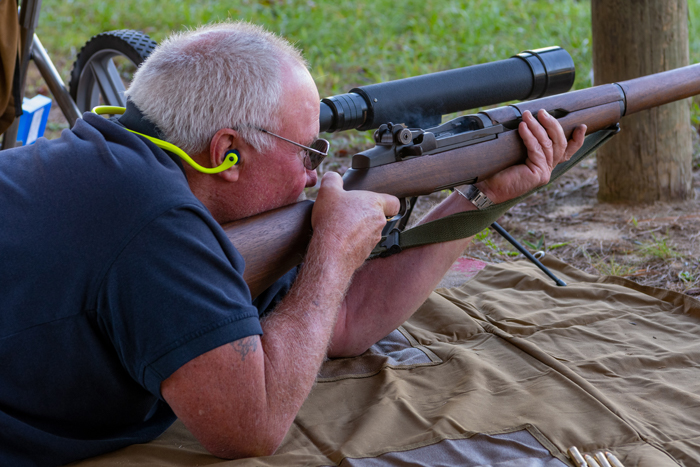
CMP Eye Protection Requirement - 2021
Rule 3.1.2 Eye and Hearing Protection –
The rule requiring the
wearing of eye and hearing protection during firing was clarified with the
following new text and illustration:
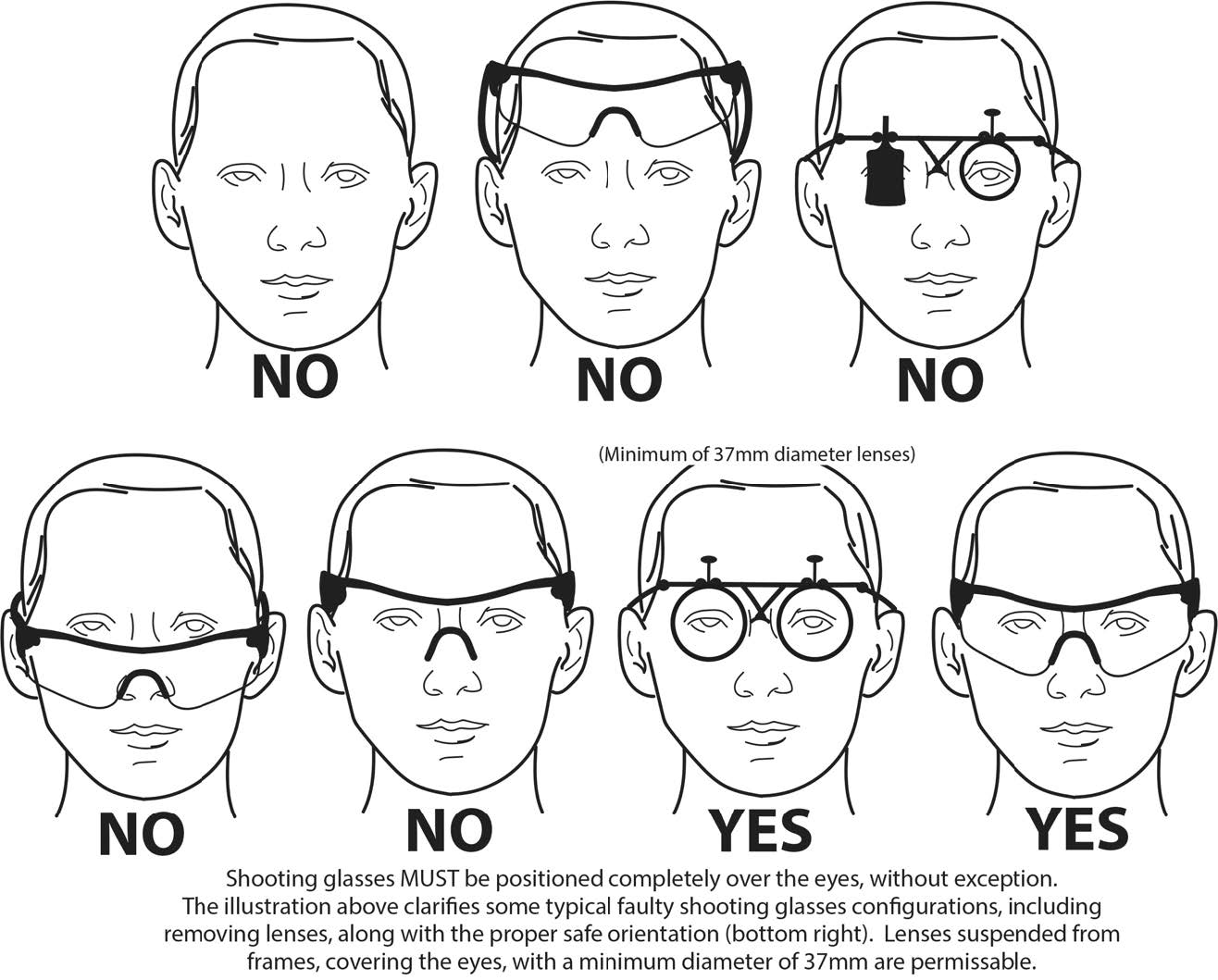
All competitors and competition officials, including Scorers or Verifiers, are required to
wear eye and hearing protection when on shooting
range firing lines during highpower rifle
or pistol firing. Eye protection must have
two complete lenses
with minimum dimensions in depth and width for each lens of 1.30 in.
It is strongly recommended that eyewear worn on firing lines meet or exceed the
ANSI Z87.1 safety standard impact protection. Competitors’ eyewear must be worn so that the two lenses remain in
front of the eyes during firing (see diagram).
No one will be allowed to participate in a CMP-sanctioned competition
unless they are wearing eyewear and hearing protection that complies with this rule. Any competitor or match official
who is not in compliance with this rule will be warned in accordance with Rule 3.12.2 a).
Refusal to comply with a warning is grounds for disqualification.
CMP Rifle Games Course of Fire (35 shots at 200 yards)
Each stage receives a three minute preparation period to get equipment ready and build the shooting position and natural point of aim.
There are no refires allowed in this match except for range alibis.
Sighting Shots (slow fire)
5 rounds, slow fire 5 minutes
Fired from a prone position.
Targets are repaired when completed.
Prone (slow fire)
10 rounds, slow fire 10 minutes
Fired while lying on the ground, single round at a time.
Score and place a new target.
Prone (rapid fire from standing)
10 rounds, rapid fire 80 seconds
Begin the stage standing, when the time begins, move down to a prone position on the ground and begin to fire.
Standing (slow fire)
10 rounds, slow fire 10 minutes
Fired from standing with no external support. The sling may not be used as a hasty sling.
Special loading procedures
Slow-Fire Loading
In all slow-fire stages, the rifle must be loaded with
only one cartridge. The rifle must remain pointed downrange while loading. A rifle may not be loaded
while the rifle butt rests on a shooting stool.
Rapid-Fire Loading
After the command ON THE FIRING LINE STAND…WITH BOLTS CLOSED ON EMPTY CHAMBERS…LOAD,
competitors with As-Issued Military Rifles, Modern Military Rifles or Special
As-Issued Military Rifles must stand with actions closed on empty
chambers or must close their rifle actions on empty chambers and
insert/load a magazine with two (2) or five (5) rounds.
Competitors with manually operated rifles must leave bolts open until they are down in
position.
Competitors with M1 Garands must place a clip and two rounds
in the magazine and close the bolt on an empty chamber by over-riding
the top round in the magazine.
When the targets rise or the command
TARGETS is given, competitors must go down into position and then cycle
or close their bolts to chamber the first round. No round may be chambered
until the competitor is down in position. A competitor is considered down
in position when the buttocks are on the ground in sitting or one elbow is
on the ground in prone.
After firing two (2) or five (5) rounds, the competitor
must reload eight (8) or five (5) rounds and continue firing. Reloading
before firing the 2nd or 5th round (‘hot reload’) is not permitted and any
competitor who does this will receive a score of zero (0) for that 10-shot series.
Standing Prior to Rifle Rapid Fire Stages
When the preparation period prior to a rifle rapid-fire stage ends, competitors
are commanded to stand. All competitors are required to stand and begin each
rapid-fire stage from the standing position if they are able to stand.
Competitors who are 70 years of age or older or competitors who have a physical or medical
condition or impairment that prevents them from standing or changing from
standing to the firing position may request permission from the Range Officer
to begin rapid-fire stages in the firing position.
These competitors are eligible
to win awards in CMP Games Matches, except that to win overall match winner
awards, competitors must start rapid-fire stages from standing.
Rapid Fire Loading Procedures for Competitors Who Start in Position
Competitors who do not stand for the start of a rapid-fire stage must follow these procedures:
a) Load on command while keeping the rifle down out of the shoulder.
b) May not shoulder the rifle until after the targets rise or the TARGETS or
START command is given.
c) May not cycle the bolt to chamber the first round or shoulder the rifle until
the firing time begins (when targets rise or the TARGETS or START command is given).
d) May not fire a shot until after a competitor who was standing fires the first shot.
Targets Used for the PRPC Match
NRA No. SR-5
Same scoring ring dimensions as the SR Military target with scoring rings through 7 only; paper size 28 x 28 inches. For use
at 200 yards on ranges with small target frames.
For our purposes, any hits on paper, outside the 7 ring scores as a six.
Aiming Black
X ring - 3.00 inches
10 ring - 7.00 inches
9 ring - 13.00 inches
Rings in White
8 ring - 19.00 inches
7 ring - 25.00 inches
The CMP Rifle Games Categories
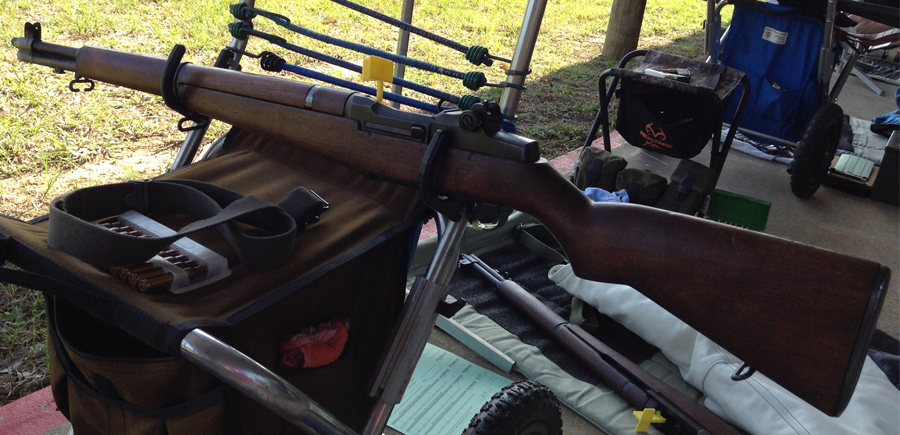
The John C. Garand
Also known as the CMP M1 Garand match. The rifle must be in as-issued condition, with
standard stock and sights. Trigger pull should be no less than 4.5 lbs. New barrels and stocks must conform to the GI
contours.
A caliber .30 M1941 Johnson rifle may be fired in matches designated as M1 Garand matches.
Unlimited Garands (match accurized and caliber .308).
Unlimited M1 Garand: An M1 Garand-type rifle that does not fully comply
with As-Issued M1 Garands. Unlimited M1 Garands must have
an M1 Garand external configuration and have a trigger pull of at least 4.5 lbs.
Unlimited M1 Garands include, but are not limited to the following:
a) National Match M1 Garands with synthetic bedding and/or NM sights;
b) M1 Garands modified to fire the 7.62 mm NATO cartridge;
c) M1 Garands with accurizing modifications such as synthetic or glass
bedding, sight adjustments finer than one minute of angle, modified upper
hand guards, etc.;
d) Commercial, replica or foreign manufactured M1 Garands;
e) M1 Garands with U. S. Government glass bedding or shims; and
f) The use of cheek-pads on these rifles is not permitted.
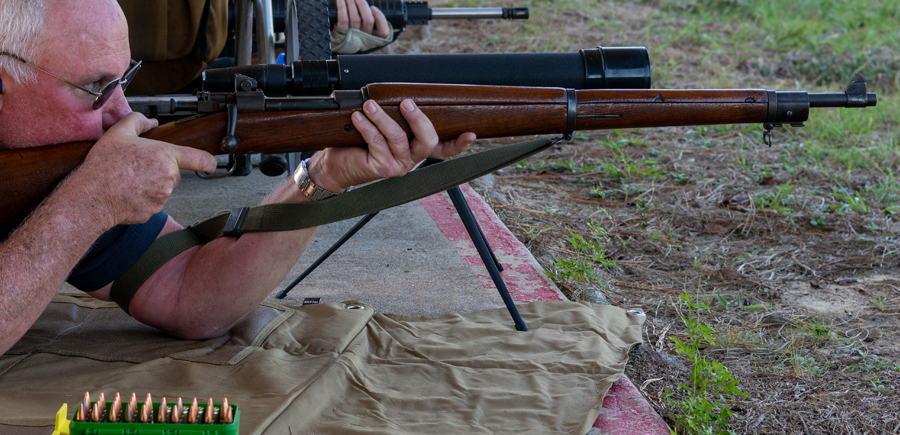
The Springfield Match
The rifle must be a standard issue service rifle that was issued by the US Armed Forces and be in as-issued condition. Permitted rifles are the Caliber .30 US Model 1903 and Model 1903 A3 Springfield rifles, except that Caliber .30 US Model 1903 Springfield rifles manufactured by Springfield Armory with serial numbers of 810,000 or lower or by Rock Island Arsenal with serial numbers of 285,506 or lower may not be used in any CMP-sanctioned competition.
Additional permitted rifles are the Caliber .30 U.S. Model 1917 and the Caliber .30-40 U. S. Krag. Other U. S.
military rifles such as the Caliber .30-40 M1895 (lever action) and 6mm caliber M1895 Lee-Navy rifle may be used.
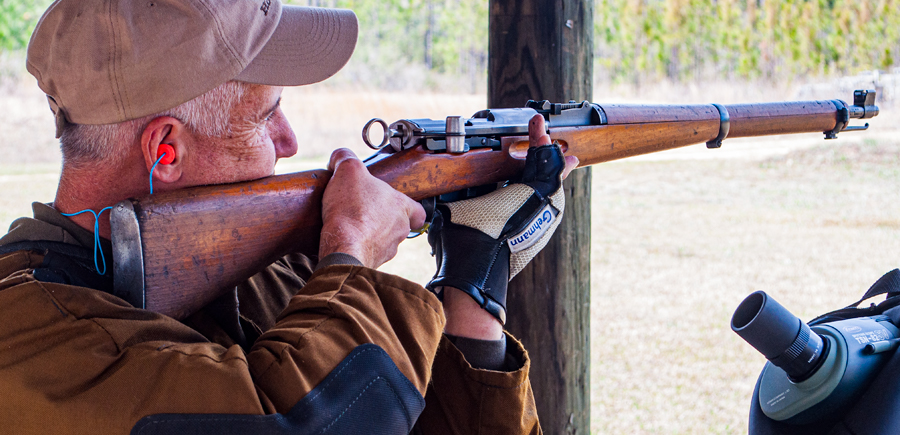
The Vintage Military Rifles (As-Issued Foreign Military Rifle):
Must be a rifle that was issued by the Armed Forces of a country other than the U. S. and be in as-issued condition. All as-issued foreign military rifles must be manually operated bolt-action or straight-pull rifles. Semi-automatic or fully automatic rifles are not permitted.
a) Rifles must be as issued by the foreign government, with a standard stock
and sights;
b) Trigger pulls may not be less than 3.5 lbs.;
c) Rifles must conform to the weight and dimension specifications of the
standard issue service rifle. Weights may not be added to the rifle;
d) Only Government Issue parts or commercial parts of the exact same
weight and dimensions may be used;
e) Sights must be of the same types that were on rifles issued to regular
military personnel. Special purpose sights designed for sniping, target
practice or competition are not permitted;
f) Rifles that were issued with pointed, inverted V front sights may be
retrofitted with flat-topped post front sights of military type. Retrofitted
front sights may not have copper bead or colored aiming elements and
may not be wider than 0.100”;
g) Rifles issued with side-mounted front sling swivels may be retrofitted with
military type sling swivels (not quick detachable) that are positioned in the
6 o’clock location, relative to its original sling swivel location (may not be
moved forward or rearward from that point). If the issue swivel was
narrower than 1 1/4” the retrofit swivel may be 1 ¼”. The as-issued sling
may be replaced with a standard U. S. military sling (Rule 3.6.1);
h) Rifles may be accurized only by the careful assembly of standard parts;
i) Rebarreling with a barrel of as-issued dimensions is permitted;
j) Shims made of wood, fabric, paper, metal or other similar material, of
types that were originally installed by military arsenals in these rifles and
that are placed between the stock and the action, barrel or trigger
assembly are permitted;
k) All as-issued rifles must be chambered for the cartridge for which they
were originally chambered;
l) Rifles may be equipped with slings originally issued with the rifle or with
a U. S. M1907 or M1 sling (see Rule 3.6.6).
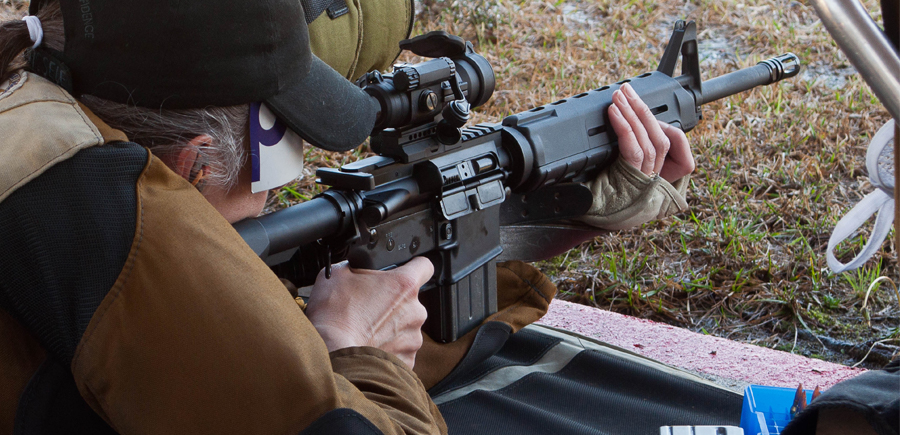
The Modern Military Rifles
Semi-automatic military rifles of U. S. or foreign manufacture or commercial rifles of the same type and caliber or commercial variations of military-type rifles may be fired.
Class A: Must be based on the M-16 rifle or be based on an AR design; manufactured by a USA manufacturer; equipped with issue-type metallic front and rear sights; rear sights with adjustments finer than one minute of angle are permitted. Total rifle weight, with sights and without sling, may not exceed 7.5 pounds. Rifles may be fitted with a float tube or free-floating handguard. A nonadjustable sling swivel may be attached to the forward end of the handguard and chambered for the 5.56x45 mm or .223 Remington cartridge.
Class B: Military Rifles manufactured in the U. S. or another country (M1A, FAL, etc.) may be used, must be equipped with standard issue-type metallic front and rear sights; rear sights with adjustments finer than one minute of angle are permitted. The rifle may be chambered for any cartridge not exceeding 8 mm.
Unlimited Modern Military: May have optical sights (reflective sights are considered optical sights) with a maximum magnification of 4.5X installed on the receiver. Variable scopes with a maximum magnification of 4.5X are permitted. Only commercially manufactured scopes that were produced with a maximum magnification of 4.5X and have a maximum objective lens diameter of 34 mm may be used.
Slow Fire Loading Procedure Demo
Slow fire in CMP and NRA rifle matches refers to a method of shooting requiring the competitor to load and fire a single round at a time. While all rifles function differently, two poplular models will be featured below in the demonstration.
Bolt Action Rifles - M1903 and 03-A3
This type rifle has a magazine "ON" and "OFF" selector. In the off position, the bolt will not open entirely disabling the internal magazine. This function works great for single round loading and dry fire.
First be sure the magazine selector switch is in the marked "OFF" position. Then open the bolt and place a single round on top of the magazine follower and guide it gently into the chamber.
With the round guided into the chamber, push the bolt forward and rotate the bolt into the locked position. Fire and repeat. This loading method is used for the slow fire prone and slow fire standing stages (including sighters).
M1 Garand Rifle
As the first semi-auto rifle issued to the eveyday soldier, the M1 is a strong rifle with a powerful, robust system. Many have heard the term "Garand Thumb," which is where a person has their thumb in the action when the bolt closes. Yes, ouch and then some. Some shy away to avoid that potential injury, but pretty much everyone who uses an M1 has been "bit" in one way or another, especially when new to the rifle.
In this section the hope is to give some good tips for loading the slow fire stages that will allow the competitor to fire thousands of rounds without ever getting their thumb between a rifle action and a rapidly closing bolt.
Start with the action open, take a single round and place it partially into the chamber. Be careful to not press down on the clip follower. Note the oprod lever toward the rear of the receiver under the windage knob. This lever is very important.
After inserting the round, place the side of the hand firmly against the oprod lever. Once in place, use the thumb to press down on the follower inside the action. There will be an audible click and pressure will be felt on the hand holding the oprod. Using the hand holding the oprod, let the bolt come forward slowly so it overrides the follower.
Then pull the thumb out of the action while the hand is holding the oprod lever. When the thumb is clear, move the hand away from the oprod lever allowing it to go home at full speed to lock up the chamber. When allowed to close at full speed using properly sized ammunition, the bolt will lock up and be ready to fire.
This loading method is used for both slow fire standing and slow fire prone stages (including sighters).
Rapid Fire Loading Demo.
Rapid Fire stages in CMP matches require being able to load the rifle and have the bolt OVERRIDE the rounds. When the time begins, the competitor will get in the firing position and then charge the rifle placing the first round in the chamber.
Bolt-action rifles are the exception. When semi-auto and bolt-action rifles are on the line at the same time, the semi-auto commands are called. Bolt-action rifles DO NOT override the first round. The bolt remains open until the competitor is on the ground in the firing position. Then the bolt is closed to begin firing.
Another wrinkle in the stage is the competitor begins the stage preparing to fire, being given the command to "STAND", upon standing the "LOAD" command is given. At this point the rifle is loaded.
When the time begins, the competitor gets into the firing position charges the rifle and fires ten rounds. Bolt-action rifles fire five and five rounds, semi-auto rifles fire two and eight rounds.
Bolt Action Rifles - M1903 and 03-A3
These rifles have a magazine "ON" and "OFF" lever. For the rapid fire stage, keep the selector in "OFF" for preparation and dry fire, then switch to "ON" before the end of the preparation period.
Before the command to "STAND", be sure to have a clip of five rounds ready to go and the magazine in the "ON" position. When the "LOAD" command is given, rest the rifle butt on the thigh, and slide the clip into the guide grooves.
Next press the rounds to feed them into the internal magazine making sure the rounds are completely in place inside the magazine. They should not easily come out. They are now ready to be stripped from the magazine into the chamber by the bolt alone.
Then remove the empty stripper clip and toss it out of the way. The rifle is now ready to begin the rapid fire stage with all rounds securely in place and the bolt open. When the time begins, get down on the ground into position and THEN close the bolt, not before.
M-1 Garand Rifle
First method, loading two rounds in a clip. There are two-round only clips available, but when all you have is a standard 8-rounder, here is a simple way to run with what you have. It takes a little practice, 10-15 tries and one will have this method ready to use with no problems.
This is a standard eight-round clip and two rounds. insert the rounds beside each other in the clip and hold them together.
While holding the rounds tightly, begin to twist using only the clip. Keep twisting the clip until the two rounds cross each other. Twist only the clip until the rounds are locked in a "V" shape.
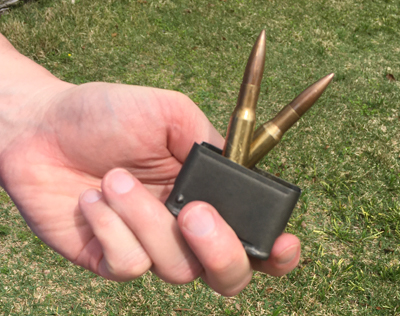
When locked, cease twisting and the loaded clip will appear similar to this. It will take a few tries to learn, but when practiced several times, this method can become very repeatable.
Loading the clip into the rifle with this method. Loading the clip in this method allows the shooter to use one hand to hold the rifle and hold the clip in the other for loading.
When the command "STAND" is given, stand up with the rifle and the loaded two-round clip. When the command "LOAD" is given, rest the rifle on the thigh and drop in the clip.
Insert the loaded clip into the action. Be careful to not allow the rounds to knock around or they may become dislodged. That would be a bit of misfortune.
Begin to press the rounds into the action. When the "V" collapses into the action, place pressure on the oprod lever with the side of the hand. Press toward the rear of the receiver. This will prevent the oprod from moving forward resulting in "Garand Thumb".
There will be an audible click when the bolt releases. Allow the oprod to move forward which will allow the bolt to move. Let the bolt move forward slowly, partially overriding the rounds.
Hold the action in place allowing the thumb to be removed from the action. Once the thumb is removed, release the action allowing it to go home at full speed on an empty chamber.
When the time begins, get on the ground into position. Then pull the oprod lever fully to the rear to load a round into the chamber and begin firing.
Second method, loading two rounds into an empty clip already in the action.
When the command "STAND" is given, stand up with the rifle, an empty clip and two rounds. When the command "LOAD" is given, hold the rifle upright, drop in the clip.
Insert the first round into the follower and then the next round on top and beside it (as when loading a full clip). Place the buttplate on the thigh for leverage, then press the side of the hand against the oprod lever toward the rear of the rifle.
There will be an audible click and then pressure will be felt on the hand as the bolt is realeased. Carefully allow the bolt to move forward overriding the rounds.
Remove the thumb from the action while holding the oprod in place with the bolt part way forward. When the thumb is securely away from the action then pull the hand away releasing the oprod lever allowing the action to go home at full speed. This locks up the bolt.
When the time begins, get on the ground into position. Then pull the oprod lever fully to the rear to load a round into the chamber and begin firing.
Achievement Awards for Marksmanship
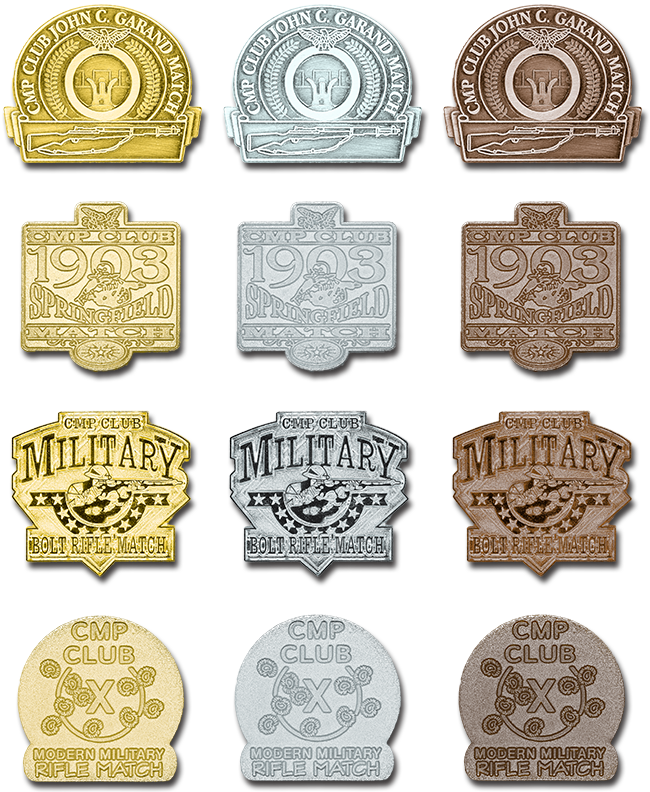
| Event |
Gold |
Silver |
Bronze |
| M1 Garand Rifle Match |
279+ |
273-278 |
261-272 |
| Springfield Rifle Match |
281+ |
273-280 |
264-272 |
| Vintage Military Rifle Match |
280+ |
271-279 |
260-270 |
| Modern Military Rifle Match |
286+ |
279-285 |
270-278 |
| Unlimited Modern Military |
293+ |
288-292 |
275-287 |
| Unlimited Garand Rifle Match |
290+ |
283-289 |
273-282 |
Return to Home Page or NRA High Power Rifle

